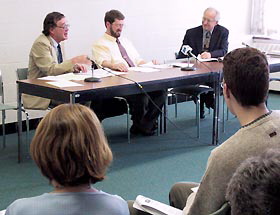|
This is an archived article.
For the latest news, go to the Advance
Homepage
For more archives, go to the Advance Archive/Search Page. | ||
|
Bioterrorism Threat Real, But Not Cause for Panic
Though there are many ways biological or chemical terrorists could strike, to worry excessively about these forms of terrorism is to play into the terrorists' hands, said a panel of experts during a Metanoia event Tuesday.
The panel, composed of a biologist, an animal scientist, and a chemist, discussed biological and chemical terrorist threats, and preventative measures. Robert Vinopal, an associate professor of molecular and cellular biology, said biological terrorism is inexpensive and potentially deadly. A biological weapon can cause the same damage as a conventional weapon for a fraction of the cost. "The economics of infectious agents are very attractive," he said. He added that biological agents also tend to be very compact. One lethal dose of anthrax, for example, would cover the head of a pin. Yet despite the small size of biological agents, terrorists would have problems delivering them, he said. It's not as simple as dumping a powder into the ventilation system of a building, since many of the particles may not end up infecting victims: "If you really want to kill a stadium full or a building full of people, it might be fairly difficult." He said several quick tests for anthrax are now available, including some that yield results within 15 minutes. It costs about $15, however, to perform one of these tests once. Such tests also make it easier for terrorists to tell whether or not they have a viable sample of anthrax. Vinopal pointed out that biological terrorism is nothing new. He cited the British distribution of smallpox-infested blankets during the French and Indian war. "Biological agents have been used crudely for a long time," he said. Lawrence Silbart, associate professor of animal science and an expert in vaccine research, discussed the dangers of agricultural bioterrorism. Introducing foot-and-mouth disease, he said, would have widespread economic impact, as evidenced by Great Britain's struggle with the disease. "It's a horrible problem to deal with," he said. A vaccine for foot-and-mouth is available, but is not used in the United States. It is expensive and there is no easy way to tell a vaccinated animal from an infected one, he said. The primary preventative strategy hinges on barring the disease from entering the country. Despite the dangers, Silbart said, the country should not expend excessive efforts on preventing such attacks. "We have to get as prepared as we can," he said, "understand the potential, and then move on." Terrorists want us to be afraid and to be thinking about their cause, he added: "The idea behind terrorism is simply terror." Arthur Dimock, assistant department head of chemistry, addressed threats from chemical terrorism. Not all chemicals are normally dangerous, but, he said, "most chemicals can be toxic if used improperly." The problem for terrorists, Dimock said, is not finding lethal chemicals, but distributing them. "To carry out an attack like this," he said, "you have to be able to distribute whatever it is you're using." Dimock cited a recent terrorist attack in a Japanese subway. The terrorists used a powerful nerve gas, he said, but caused limited casualties owing to the primitive delivery method. The threats from biological and chemical terrorism are real, said the panel. But the best approach is to prepare reasonably and then move on. Brent C. Evans |

